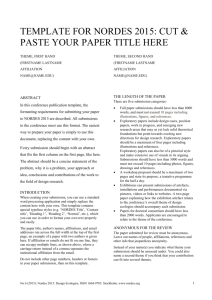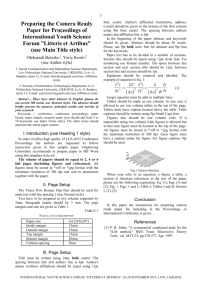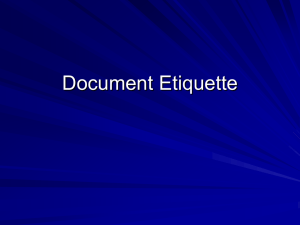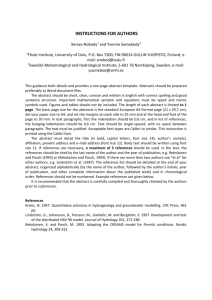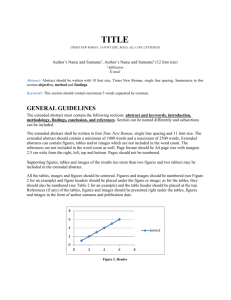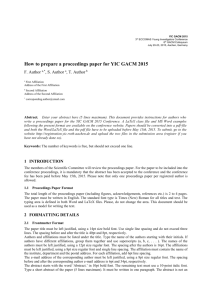Paper Template & Instructions
advertisement
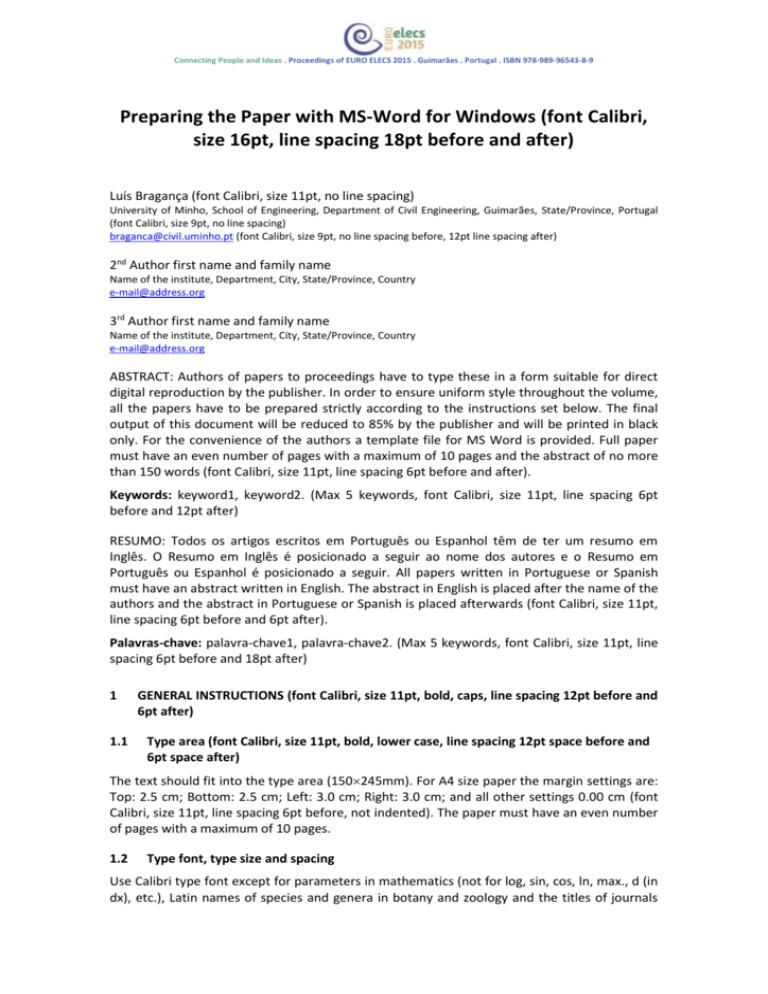
Connecting People and Ideas . Proceedings of EURO ELECS 2015 . Guimarães . Portugal . ISBN 978-989-96543-8-9 Preparing the Paper with MS-Word for Windows (font Calibri, size 16pt, line spacing 18pt before and after) Luís Bragança (font Calibri, size 11pt, no line spacing) University of Minho, School of Engineering, Department of Civil Engineering, Guimarães, State/Province, Portugal (font Calibri, size 9pt, no line spacing) braganca@civil.uminho.pt (font Calibri, size 9pt, no line spacing before, 12pt line spacing after) 2nd Author first name and family name Name of the institute, Department, City, State/Province, Country e-mail@address.org 3rd Author first name and family name Name of the institute, Department, City, State/Province, Country e-mail@address.org ABSTRACT: Authors of papers to proceedings have to type these in a form suitable for direct digital reproduction by the publisher. In order to ensure uniform style throughout the volume, all the papers have to be prepared strictly according to the instructions set below. The final output of this document will be reduced to 85% by the publisher and will be printed in black only. For the convenience of the authors a template file for MS Word is provided. Full paper must have an even number of pages with a maximum of 10 pages and the abstract of no more than 150 words (font Calibri, size 11pt, line spacing 6pt before and after). Keywords: keyword1, keyword2. (Max 5 keywords, font Calibri, size 11pt, line spacing 6pt before and 12pt after) RESUMO: Todos os artigos escritos em Português ou Espanhol têm de ter um resumo em Inglês. O Resumo em Inglês é posicionado a seguir ao nome dos autores e o Resumo em Português ou Espanhol é posicionado a seguir. All papers written in Portuguese or Spanish must have an abstract written in English. The abstract in English is placed after the name of the authors and the abstract in Portuguese or Spanish is placed afterwards (font Calibri, size 11pt, line spacing 6pt before and 6pt after). Palavras-chave: palavra-chave1, palavra-chave2. (Max 5 keywords, font Calibri, size 11pt, line spacing 6pt before and 18pt after) 1 1.1 GENERAL INSTRUCTIONS (font Calibri, size 11pt, bold, caps, line spacing 12pt before and 6pt after) Type area (font Calibri, size 11pt, bold, lower case, line spacing 12pt space before and 6pt space after) The text should fit into the type area (150245mm). For A4 size paper the margin settings are: Top: 2.5 cm; Bottom: 2.5 cm; Left: 3.0 cm; Right: 3.0 cm; and all other settings 0.00 cm (font Calibri, size 11pt, line spacing 6pt before, not indented). The paper must have an even number of pages with a maximum of 10 pages. 1.2 Type font, type size and spacing Use Calibri type font except for parameters in mathematics (not for log, sin, cos, ln, max., d (in dx), etc.), Latin names of species and genera in botany and zoology and the titles of journals Connecting People and Ideas . Proceedings of EURO ELECS 2015 . Guimarães . Portugal . ISBN 978-989-96543-8-9 and books which should all be in italics. Never use bold, except to denote vectors in mathematics. Never underline any text. Use the small font (size 9pt) for table captions, figure captions and references. Never use letter spacing and never use more than one space after each other. 2 2.1 GETTING STARTED The template file The easiest way to prepare the paper is to write (or paste without format) your text to this file. 2.2 Title, author and affiliation frame At the top of your newly named file, type the title of the paper in lower case (no caps except for proper names). The title should not be longer than 75 characters. Type the name of the first author (first the first name and then the family name), the correct affiliation, Name of the institute, City, State/Province, Country, do not add street names, P.O. Box numbers or zip codes to the affiliations. Then type the name of the other authors as for the first author. 2.3 Abstract Type your abstract in English and in Portuguese or Spanish of no more than 150 words. First is the Abstract in English and afterwards the abstract in Portuguese or Spanish. Papers written in English do not require an abstract Portuguese or Spanish. 3 3.1 LAYOUT OF TEXT Text and indenting (font Calibri, size 11pt, line spacing 6pt before) If your text starts with a heading, type the correct text for the heading and start with the text after a return. All text, figures, tables, etc. should fit exactly in the type area of 150×245mm. All text should be typed in Calibri. All text is 11pt on 6pt line spacing before except for the paper title (16pt on 18pt line spacing before and after), author(s) (11pt on 0pt), affiliation(s) (9pt on 0pt) and the text in captions and references (9pt on 12pt). All line spacing is exact. Never add an extra line space between lines or paragraphs. First lines of paragraphs are not indented (because of the 6pt line spacing). Equations are indented 12mm (0.47"). 3.2 Headings Capitalize major words in primary headings, use lower case letters in secondary and tertiary headings. Headings are set flush against the left margin. Leave 12pt blank space above all headings. Headings are not indented. 3.3 Listing and numbering When listing facts use bullet points after an introducing text ended with a colon, like this example: prefer to start with lower case letters; use the verbs in the same tense; put semicolon to finish the intermediate items; finish using full stop. Connecting People and Ideas . Proceedings of EURO ELECS 2015 . Guimarães . Portugal . ISBN 978-989-96543-8-9 3.4 Equations Use the equation editor of the selected word processing programme. Equations are indented 12mm (0.47") from the left margin. Number equations consecutively and place the number with the tab key at the end of the line, between parentheses. Refer to equations by these numbers. See for example Equation 1 below: Kt 1 ca tan R2 4 k1 (1) where ca = interface adhesion; = friction angle at interface; and k1 = shear stiffness number. 3.5 Tables Locate tables close to the first reference to them in the text and number them consecutively. Avoid abbreviations in column headings. Indicate units in the line immediately below the heading. Explanations should be given at the foot of the table, not within the table itself. Use only horizontal borders: One above and one below the column headings and one at the foot of the table. Align all headings to the left of their column and start these headings with an initial capital. Type the caption above the table to the same width as the table. See for example Table 1. The size of the content of the tables must be 10pt size and no line space. Table 1. Margin settings for A4 size paper. Setting Top Bottom Left Right All other A4 size paper cm inches 2.5 0.98" 2.5 0.98" 3.0 1.18" 3.0 1.18" 0.0 0.00" Continuation of the text. Text text text text text text text text text text text text text text text text text text text text text text text text text text text text text text text text text text text text text text text text text. Text text text text text text text text text text text text text text text text text text text text text text text text text text text text text text text text text text text text text text text text text Text text text text text text text text text text text text text text text text text text text text text text text text text text text text text text. 3.6 Figure captions For figures captions, always use 9pt size and line spacing 12pt. Place the caption underneath the figure (see Section 4). Type as follows: ‘Figure 1. Caption.’ Leave 12pt space before (or after, it depends on the type - table, figure) the figure caption and the text of the paper. 3.7 References In the text, place the authors' last name (without initials) and the date of publication in parentheses, like (Larch, 1996b, Larch, 1997). At the end of the paper, list all references in alphabetical order underneath the heading REFERENCES. The references should be typed in small text (9pt on 12pt line spacing). If several works by the same author are cited, entries should be chronological: Larch, A.A. 1996a. Development ... Connecting People and Ideas . Proceedings of EURO ELECS 2015 . Guimarães . Portugal . ISBN 978-989-96543-8-9 Larch, A.A. 1996b. Facilities ... Larch, A.A. 1997. Computer ... Larch, A.A. & Jensen, M.C. 1996. Effects of ... Larch, A.A. & Smith, B.P. 1993. Alpine ... In bibliographies the order for books and journals are respectively: Last name, First name or Initials (ed.) year. Book title. City: Publisher. Last name, First name or Initials year. Title of article. Title of Journal (series number if necessary) volume number (issue number if necessary): page numbers. Examples: Grove, A.T. 1980. Geomorphic evolution of the Sahara and the Nile. In M.A.J. Williams & H. Faure (eds), The Sahara and the Nile: 21-35. Rotterdam: Balkema. Jappelli, R. & Marconi, N. 1997. Recommendations and prejudices in the realm of foundation engineering in Italy: A historical review. In Carlo Viggiani (ed.), Geotechnical engineering for the preservation of monuments and historical sites; Proc. intern. symp., Napoli, 3-4 October 1996. Rotterdam: Balkema. Johnson, H.L. 1965. Artistic development in autistic children. Child Development 65(1): 13-16. Polhill, R.M. 1982. Crotalaria in Africa and Madagascar. Rotterdam: Balkema. 3.8 Notes Notes should be avoided. Insert the information in the text. In tables the following reference marks should be used: *, **, etc. and the actual footnotes are set directly underneath the table. 3.9 Conclusions Conclusions should state concisely the most important propositions of the paper as well as the author’s views of the practical implications of the results. 4 PHOTOGRAPHS AND FIGURES Number figures consecutively in the order in which reference is made to them in the text, making no distinction between diagrams and photographs. Figures should fit within the type area width of 150mm (5.91"). Figures, photographs, etc. can be coloured but, because the proceedings will be printed in black and white only, all images should have good contrast and definition. Photographic reproductions cut from books or journals, photocopies of photographs and screened photographs are unacceptable. Paste same size copies where you want them to appear in the text. Do not place them sideways on a page; however if this cannot be avoided, no other text (except the figure caption) should appear on that page. They should not be centred, but placed against the left margin. Leave two lines of space between the actual text and figure (including caption). Never place any text next to a figure. Leave this space blank. The most convenient place for placing figures is at the top or bottom of the page. Line drawings (as well as photographic reproductions of these) should be in black (not grey) on white. The minimum size of the lettering should be 9pt. Lines should preferably be 0.2mm (0.1") thick. Keep figures as simple as possible. Avoid excessive notes and designations. Connecting People and Ideas . Proceedings of EURO ELECS 2015 . Guimarães . Portugal . ISBN 978-989-96543-8-9 Figure 1. Caption of a typical figure. Continuation of the text. Text text text text text text text text text text text text text text text text text text text text text text text text text text text text text text text text text text text text text text text text text. Text text text text text text text text text text text text text text text text text text text text text text text text text text text text text text text text text text text text text text text text text Text text text text text text text text text text text text text text text text text text text text text text text text text text text text text text text text text text text text text text text text text. Text text text text text text text text text text text text text text text text text text text text text text text text text text text text text text text text text text text text text text text text text. Text text text text text text text text text text text text text text text text text text text text text text text text text text text text text text text text text text text text text text text text text. 5 PREFERENCES, SYMBOLS AND UNITS Consistency of style is very important. Note the spacing, punctuation and caps in all the examples below. References in the text: Figure 1, Figures 2-4, 6, 8a, b (not abbreviated) References between parentheses: (Fig. 1), (Figs 2-4, 6, 8a, b) (abbreviated) USA / UK / Netherlands / the Netherlands instead of U.S.A. / U.K. / The Netherlands Author & Author (1989) instead of Author and Author (1989) (Author 1989a, b, Author & Author 1987) instead of (Author, 1989a,b; Author and Author, 1987) (Author et al. 1989) instead of (Author, Author & Author 1989) Use the following style: (Author, in press); (Author, in prep.); (Author, unpubl.); (Author, pers. comm.) Always use the official SI notations: kg / m / kJ / cm instead of kg. (Kg) / m. / kJ. (KJ) / cm.; 20°1632SW instead of 20° 16 32 SW 0.50 instead of 0,50 (used in French text); 9000 instead of 9,000 but if more than 10,000: 10,000 instead of 10000 14C instead of C14 / C-14 and BP / BC / AD instead of B.P. / B.C. / A.D. 4 + 5 > 7 instead of 4+5>7 but -8 / +8 instead of - 8 / + 8 e.g. / i.e. instead of e.g., / i.e., Connecting People and Ideas . Proceedings of EURO ELECS 2015 . Guimarães . Portugal . ISBN 978-989-96543-8-9 6 PAPER SUBMISSION Check whether the paper looks the same as this sample: Title at top of first page in 16pt, with line spacing 18pt before and 18pt after, all other text in 11pt on 6pt line space, except for the small text, like references (9pt size and 12pt line space), affiliations of the authors (9pt size and no line space), tables (10pt size and no line space), captions (9pt and 12pt line spacing). Also check if the type width is 150mm and the page length is 245mm. This material must be submitted to the Conference Secretariat through the EasyChair system (http://www.easychair.org) by the deadline. Any material received after the deadline will not be accepted. The paper should be sent in full in MS-Word for Windows format.
